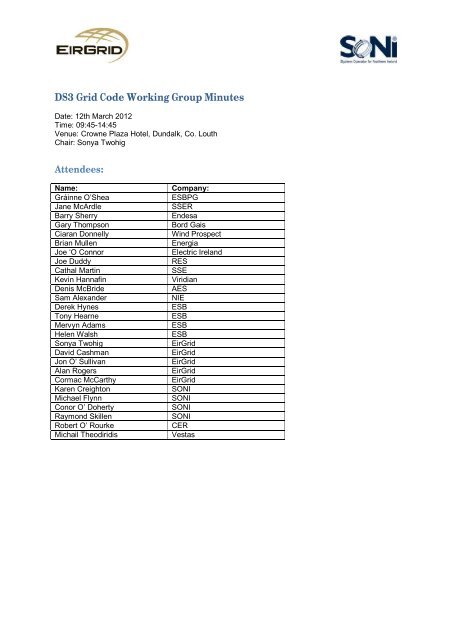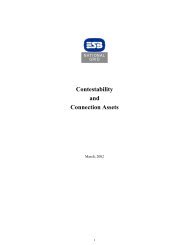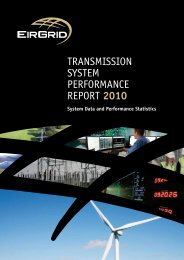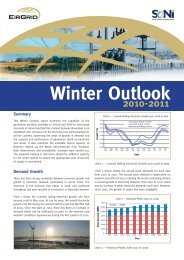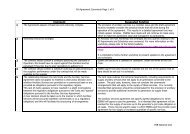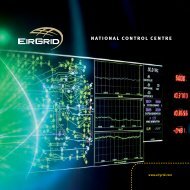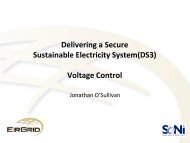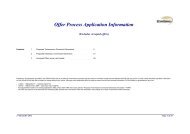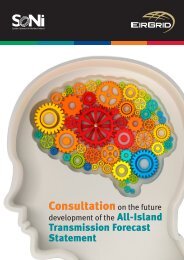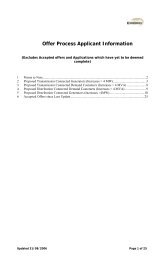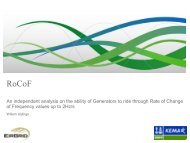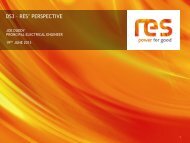DS3 GC WG Minutes 12-03-2012 v1 - Eirgrid
DS3 GC WG Minutes 12-03-2012 v1 - Eirgrid
DS3 GC WG Minutes 12-03-2012 v1 - Eirgrid
You also want an ePaper? Increase the reach of your titles
YUMPU automatically turns print PDFs into web optimized ePapers that Google loves.
<strong>DS3</strong> Grid Code Working Group <strong>Minutes</strong>Date: <strong>12</strong>th March 20<strong>12</strong>Time: 09:45-14:45Venue: Crowne Plaza Hotel, Dundalk, Co. LouthChair: Sonya TwohigAttendees:Name:Gráinne O’SheaJane McArdleBarry SherryGary ThompsonCiaran DonnellyBrian MullenJoe ‘O ConnorJoe DuddyCathal MartinKevin HannafinDenis McBrideSam AlexanderDerek HynesTony HearneMervyn AdamsHelen WalshSonya TwohigDavid CashmanJon O’ SullivanAlan RogersCormac McCarthyKaren CreightonMichael FlynnConor O’ DohertyRaymond SkillenRobert O’ RourkeMichail TheodiridisCompany:ESBPGSSEREndesaBord GaisWind ProspectEnergiaElectric IrelandRESSSEViridianAESNIEESBESBESBESBEirGridEirGridEirGridEirGridEirGridSONISONISONISONICERVestas
ROCOF Discussion Paper:Presentation by Gráinne O’ Shea – Conventional Plant PerspectiveDiscussion Topics:• Gráinne O’ Shea: ESBPG have conducted studies which largely conform to findings EirGridhave published in the Facilitation of Renewables Report.• Gráinne O’ Shea: ESBPG are questioning if there are any more significant gains to be madein the area of reducing minimum generation levels for conventional sets. Alstom have statedthat they can reach a level of 20% of maximum output however this can only be operated atfor a limited time. Also when operating at this point the unit does not provide reserve anddoes not have governing action. Furthermore it would require retrofitting of units that couldhave significant costs.• Gráinne O’ Shea: The current system employed by EirGrid is to apply a penalty for notmeeting the declared minimum generation level and ESBPG would prefer this to be reversedto an incentive for reducing minimum generation levels however even with this it would bedifficult to reduce levels significantly further.• Gráinne O’ Shea: ESBPG have engaged with OEMs on ROCOF capabilities for theirtechnologies but OEMs have not provided a definitive answer on the capabilities of the units.ESBPG are therefore looking to conduct their own investigation.• Gráinne O’ Shea: The plant is to be broken into categories for the analysis: Electrical,Mechanical, Control and Instrumentation (C & I) and Turbine. The aim is to determine thelimiting factors in the plant.• Gráinne O’ Shea: ESBPG to produce a document outlining the likely approach to the analysisand will be looking for feedback from TSOs. Any improvement in ROCOF performance wouldlikely take 2-3 years to complete.• Jon O’ Sullivan: Agree with ESBPG on minimum generation levels of conventional units willlead to little gain and therefore should resources be concentrated on ROCOF issue. A groupconsensus on this is required.• Jon O’ Sullivan: There is no current Grid Code specification in the NI Grid Code for ROCOFand therefore what are the perceived limitations for NI generators?• Denis McBride: Protection settings for steam turbines may pose an issue for steam turbinesand there would also likely be mechanical issues.• Raymond Skillen: Would it be effective to just investigate the base load plant and prioritisethese units as indicators for the rest of the system.• Michael Flynn: Approximately half of the conventional sets in NI have been tested incommissioning for a ROCOF of 1.5 Hz/s.• Raymond Skillen: Simulations and load rejection tests have also been carried out to back upthe SONI ROCOF test results.• Gary Thompson: Bord Gais to take similar approach to ESBPG in investigating ROCOFcapabilities of its plant. Have found that the control system can go above 0.5 Hz/s but othercomponents may have issues.• Jon O’ Sullivan: ENTSO-e standard of 2 Hz/s is not likely to be passed for 2-3 years.Retrospective application of this standard is subject to cost benefit analysis.• Ciaran Donnelly: OEMs may have performed the cost benefit analysis themselves and mayhave some answers on it.• Gary Thompson: OEMs will sell plant that is compliant with a ROCOF of 2 Hz/s.• Raymond Skillen: Plant may have bigger issues with a high frequency ROCOF due to aninterconnector trip rather than a low frequency ROCOF due to generator tripping.• Ciaran Donnelly: Most wind curtailment occurs due to units reaching their minimumgeneration levels and not due to SNSP and therefore effort should be made to further reducethe minimum generation levels.
Presentation by Cathal Martin – Wind Farm Power Station PerspectiveDiscussion Topics:• Cathal Martin: Contacted OEMs to get feedback on ROCOF. Analysis of existing technologysuggested that over 90% of existing fleet could meet the 2 Hz/s ROCOF requirement.• Cathal Martin: DSO connected WFPS have protection relays that trip from 0.4-0.55 Hz/s andthis needs to be changed as it is the limiting factor. It may possibly be better to move to vectorshift protection.• Cathal Martin: The Fault ride through (FRT) times for several of the turbines could be reducedfrom 1s. Siemens could be reduced to 200 ms but this would be for newer technologies.Similarly GE believe that their turbine could recover within 500 ms but further testing would berequired to find the limit. Vestas Full-Converter turbines could achieve 100 ms but VestasDFIG turbines would be restricted to approximately 1s.• Michail Theodiridis: Mechanical oscillations in the tower are the limiting factor for the DFIGturbine.• Ciaran Donnelly: Enercon have a ROCOF capability of 4 Hz/s and a FRT recovery time ofapproximately 60 ms.• Jon O’ Sullivan: Similar analysis to that which has been proposed for conventional generatorsshould be performed to determine capabilities of WFPS.• Raymond Skillen: SONI will be testing WFPS with 1.5 Hz/s injection during commissioningtesting and will also have type testing results.• Cathal Martin: For GE to be fully confident in their turbines capabilities they will need to re-dotype tests and these tests are likely to be costly.• Jon O’ Sullivan: EirGrid to employ similar testing procedures as SONI are currentlyperforming but the detailed processes will need to be developed.• Michail Theodiridis: Industry can provide input into developing the testing processes• Jon O’ Sullivan: Once standards have been set they must be enforced. Industry shouldengage with TSOs and Regulators to ensure this is done.• Joe Duddy: Need a full and clear definition for ROCOF and Frequency calculation.• Jon O’ Sullivan: Agrees and will give feedback on this issue at next Working Group meeting.• Tony Hearne: How to Apply the DSO/TSO standards to embedded generation less than 5MW on the system?• Jon O’ Sullivan: TSOs and DSOs are currently in discussions on this and will aim to developan agreed process on handling this type of generation.Action Items:• Conventional Generators and Wind Farm representatives to each produce a 2-3 pagedocument outlining approach to assessing ROCOF capabilities of of 2Hz/sec.• TSOs to review responses from members on approaches to ROCOF and at next meetingprovide a summary of the responses and a recommendation on the next steps• TSOs to circulate Universal Windfarm Standards document to GE and Nordex and follow upfor feedback.• TSOs and DSOs to develop processes on applying TSO and DSO standards to embeddedgeneration less than 5 MW for July/August.• TSOs to prepare document on ROCOF calculation and definition for presentation at the nextmeeting.
Universal Wind Farm Standards:Presentation provided by Alan RogersDiscussion Topics:• Alan Rogers: Full reactive power range of WFPS should be utilised and this may involve theWFPS providing a Statcom like response.• Joe Duddy: It may be difficult for WFPS to provide the required reactive power response atthe point of connection within the timeframe specified. This is because most turbines havetheir reactive power responses controlled at their individual connections rather than theWFPS connection point.• Joe Duddy: Changing from different reactive power modes may cause a step change inreactive power and could cause a system event.• Joe Duddy: Issues may occur when transferring from constant power factor mode toEmergency voltage control mode as chattering between modes may occur. There needs to bemore flexibility in setting of slopes in emergency voltage control mode.• Sam Alexander: The changeover process would need to be monitored and deadbands mayneed to be included to avoid issues.• Joe Duddy: Why is there a requirement on WFPS to provide reactive power when at zero realpower output?• Jon O’ Sullivan: This is in relation to voltage collapse issues which have been seen in theNorth West of the country during times when there was low wind and high demand in theregion.• Jon O’ Sullivan: WFPS will be required to provide reactive support but should be paid throughincentives to provide these system services. Statcoms may need to be installed to provide thereactive power requirement but this could be shared between WFPS clusters.• Joe Duddy: Why is the reactive power requirement only on generators and not also applied toother network users?• Jon O’ Sullivan: There is a requirement stated in the Planning Code for the TSO to developthe network with appropriate reactive power capabilities however an alternative option wouldbe for WFPSs to provide Statcom like performance.• Joe Duddy: There are costs associated with providing reactive power response for FullConverter type turbines and DFIGs will not have the capability to provide the requiredresponse and would therefore require a Statcom. There needs to be suitable compensationstructures in place for this.• Jon O’ Sullivan: A ‘Polluter Pays’ type model could be employed to provide the requiredcompensation.• Cathal Martin: Individual WFPS should have intelligent control systems that would avoidhunting on the system but in the case of multiple WFPSs in a cluster there may be issues.• Jon O’ Sullivan: This would need to be reviewed but by having multiple control options anoverall strategy for the cluster could be achieved.• Tony Hearne: The current DSO code needs to be clarified to have a similar voltage controlrequirement as has been proposed in the Universal Windfarm Standards document.• Joe Duddy: ENTSO-e has specified a 500 ms time for the response of WFPS for fault ridethrough.• Jon O’ Sullivan: What is a reasonable expectation for FRT? Is 100-200 ms realistic?• Joe Duddy: As long as this does not impact negatively on developers and does not restrictmanufacturers it can be acceptable.• Michail Theodiridis: Full Converter technology could meet 100-200 ms but DFIG technologywould have difficulty with this. 500 ms would be a reasonable number.• Joe Duddy: Regarding active power response and ramping rates there should be clarity overthe ramping rate settings. There should possibly be prioritisation of control modes. Forexample frequency control would take highest priority, a dispatch instruction would be nextand finally wind following.• Joe Duddy: WFPS have gone unstable for low short-circuit MVA levels. What is the TSOscommitment on minimum MVA levels?
• Jon O’ Sullivan: In the absence of studies the risk would be on the developer however theTSO issues a specific MVA level for conventional generation applications and this could beapplied in the case of WFPS also.• Joe Duddy: Any commitment on Short-Circuit MVA level from the TSO would be welcome.• Cormac McCarthy: What if multiple WFPSs connect to the same node? How does this affecttheir stability in relation to MVA levels?• Tony Hearne: There may be issues regarding low short-circuit MVA levels for DSO connectedWFPS and this needs to be resolved.• Alan Rogers: Have seen High Wind Speed (HWS) Shutdown below 25 m/s and in somecases between 17-18 m/s.• Joe Duddy: This needs to be investigated further as a shutdown setting of 17/18 m/s would beunlikely and measurements of the wind speed to be 17-18 m/s were most likely incorrect.• Jon O’ Sullivan: Have done analysis that suggests that approximately 50% of wind farms willhave shutdown at 25 m/s. A specification should be given in the Grid Code for when HWSshutdown would occur.• Joe Duddy: Having one particular figure would be difficult as each turbine has uniquemeasurement and TSO should actually require some signal to warn of imminent HWSshutdown. A Power curve that predicts WFPS behaviour and gives certainty of behaviourwould be a more realistic solution.• Cathal Martin: It is not possible to predict wind speeds at each turbine from onemeasurement. Turbines will shut themselves down for safety reasons if wind it sees is toohigh.• Jon O’ Sullivan: There is an uncertainty around 25 m/s which increases risk and thereforelarger curtailment is enforced to carry a higher safety margin at these speeds. In order toreduce this a shutdown speed should be established and specified in Grid Code.• Joe Duddy: There should be a focus on WFPS obligations in Grid Code. WFPS shouldprovide performance of individual turbines and not on a farm level.• Sam Alexander: It should be possible to obtain a profile across the wind farm site and specifythe HWS shutdown level.• Joe Duddy: WFPS developers are against shutting down the turbines before 25 m/s as theylose revenue or shutting them down after 25 m/s as this is in breach of warranty.• Joe Duddy: A suitable obligation on WFPS should be specified in the grid code.Action Items:• TSOs to provide a feedback table on Universal Windfarm Standards.• Each member is to fill in responses and return them by March 30 th 20<strong>12</strong>.• Joe Duddy to provide further information on Voltage control, ramping settings and High WindSpeed Shutdown to TSOs.
Other Action Items:• The next <strong>DS3</strong> Grid Code Working Group Meeting has been confirmed for Monday April 16 th .• TSOs to circulate the Terms of reference document to Joint Grid Code Review Panel andhave it formally ratified at the next meeting in May.No Action Responsibility Completion Date1. • Issue the 2 nd Meeting presentations inPDF to members2. • Issue revised ToR document toJ<strong>GC</strong>RP before next meeting.3. • Issue draft <strong>Minutes</strong> and Actions from2 nd Working Group meeting tomembers4. • Issue Universal Wind Farm Standardsfeedback table• Each member to fill out table withresponses and return to TSOs• TSOs to review responses for nextmeeting5. • Members to provide 2-3 pagedocuments to TSOs outliningapproach to determining ROCOFcapabilities of plant (both conventionalgenerators and WFPS)• TSOs to review documents for nextmeeting.TSOsTSOsTSOsTSOsAllTSOsConv. Gens/WFPSTSOsw/e 16 th March14 th Aprilw/e 16 th March16 th March30 th March14 th April30 th March14 th April6. • TSO and DSO to discuss the theprocess for applying grid codestandards to embedded generationTSOs and DSOs July/August 20<strong>12</strong>7. • Joe Duddy to providerecommendations regarding Voltage Joe Duddy 30 th MarchControl, Ramping and High WindSpeed Shutdown for UniversalWindfarm Standards.8. • Issue Meeting 3 Agenda TSOs w/b 2 nd April


